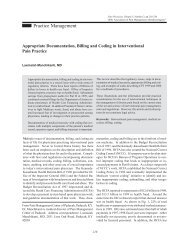ASIPP Practice Guidelines - Pain Physician
ASIPP Practice Guidelines - Pain Physician
ASIPP Practice Guidelines - Pain Physician
Create successful ePaper yourself
Turn your PDF publications into a flip-book with our unique Google optimized e-Paper software.
Manchikanti et al • <strong>ASIPP</strong> <strong>Practice</strong> <strong>Guidelines</strong><br />
68<br />
dure with placement of either the needle and/or catheter,<br />
and complications related to the administration of various<br />
drugs. Complications include dural puncture, spinal cord<br />
trauma, and infection.<br />
Accidental dural puncture, subdural injection, neural<br />
trauma, injury to the spinal cord, and hematoma formation<br />
have been described. The incidence of dural puncture following<br />
lumbar epidural injections has been reported as<br />
0.33% (60) and 0.25% after cervical epidural injections<br />
(730). Subdural intracranial air was also reported following<br />
epidural injections (731, 732). In addition, lumbar<br />
puncture has been reported following facet joint injections<br />
and sympathetic blocks (733-735). When C3/4, C4/5, or<br />
C5/6 facet joint blocks, the phrenic nerve may be compromised,<br />
especially if a large volume of local anesthetic is<br />
employed. This is also a complication of sympathetic block<br />
in the cervical spine. Spinal cord trauma, spinal cord or<br />
epidural hematoma formation is a catastrophic complication<br />
rarely seen following the interventional procedures in<br />
the cervical spine, thoracic spine or upper lumbar spine<br />
(60, 538-542, 736-738). It has been suggested to perform<br />
interventional procedures with placement of a needle only<br />
in an awake patient and in the cervical spine by limiting<br />
the midline injection to be performed only at C7/T1 except<br />
in rare circumstances (538-542). However, unfortunately,<br />
it has been reported that even an awake patient may<br />
not be able to detect spinal cord puncture (739). Injection<br />
of neurolytic solutions or placement of radiofrequency<br />
needle into the spinal cord could lead to disastrous complications.<br />
Infectious complications include epidural abscess and bacterial<br />
meningitis (740-756). However, iatrogenic spinal<br />
epidural abscess (757) and iatrogenic mycobacterium infection<br />
after an epidural injection was also reported (758).<br />
Discitis is considered as a principle complication of cervical<br />
discography which is seen less frequently following<br />
lumbar discography in approximately 0.1% to 1% of the<br />
patients (759, 760). Other complications include inadvertent<br />
subdural injection of local anesthetic and steroids (761,<br />
762), development of complex regional pain syndrome<br />
(763), chemical meningism (764), lightheadedness, flushing,<br />
sweating, nausea, hypotension, syncope, pain at the<br />
injection site, and nonpostural headache (60). Retinal hemorrhage<br />
also has been associated with rapid injection of<br />
large volumes of caudal steroid injections (765).<br />
Side-effects related to the administration of steroids are<br />
generally attributed either to the chemistry or to the pharmacology<br />
of the steroids. The major theoretical complications<br />
of corticosteroid administration include suppression<br />
of pituitary-adrenal axis, hypercorticism, Cushing’s<br />
syndrome, osteoporosis, avascular necrosis of bone, steroid<br />
myopathy, epidural lipomatosis, weight gain, fluid<br />
retention, and hyperglycemia (766-774). However, Manchikanti<br />
et al (775) in evaluating the effect of neuraxial<br />
steroids on weight and bone mass density showed no significant<br />
difference in patients undergoing various types of<br />
interventional techniques with or without steroids. Catheter<br />
shearing and inadvertent injection of hypertonic saline<br />
into the subarachnoid space as well as complications<br />
of hypertonic saline injection also have been described<br />
(632, 776-783). The most commonly used steroids in neural<br />
blockade in the United States, methylprednisolone acetate,<br />
triamcinolone acetonide, and betamethasone acetate<br />
and phosphate mixture have been shown to be safe at epidural<br />
therapeutic doses in both clinical and experimental<br />
studies (784-790).<br />
Potential side-effects with radiofrequency denervation include<br />
painful cutaneous dysesthesias, increased pain due<br />
to neuritis or neurogenic inflammation, anesthesia dolorosa,<br />
cutaneous hyperesthesia, pneumothorax, and deafferentation<br />
pain, and finally inadvertent lesioning of the spinal<br />
cord and its contents (791).<br />
Complications related to IDET, spinal cord stimulation,<br />
and intrathecal morphine implantation include various technical<br />
complications described above, other complications<br />
related to surgical technique itself, and fracture of the electrodes,<br />
shearing of the catheter, and complications related<br />
to long-term implantables.<br />
DELIVERY OF INTERVENTIONAL<br />
TECHNOLOGY<br />
Dosage, Frequency, And Number of Blocks<br />
There is no consensus among the interventional pain management<br />
specialists with regards to type, dosage, frequency,<br />
total number of injections, or other interventions (31, 33,<br />
41-62, 338, 339, 607, 608, 792). Yet significant attention<br />
in the literature seems to be focused on the complications<br />
attributed to the use of epidural steroids in the entire arena<br />
of interventional pain management. Thus, various limitations<br />
of interventional techniques, specifically neural blockade,<br />
have arisen from basically false impressions. Based<br />
on the available literature and scientific application, the<br />
most commonly used formulations of long-acting steroids,<br />
which include methylprednisolone (DepoMedrol ® ), triamcinolone<br />
diacetate (Aristocort ® ) triamcinolone acetonide<br />
<strong>Pain</strong> <strong>Physician</strong> Vol. 4, No. 1, 2001
















